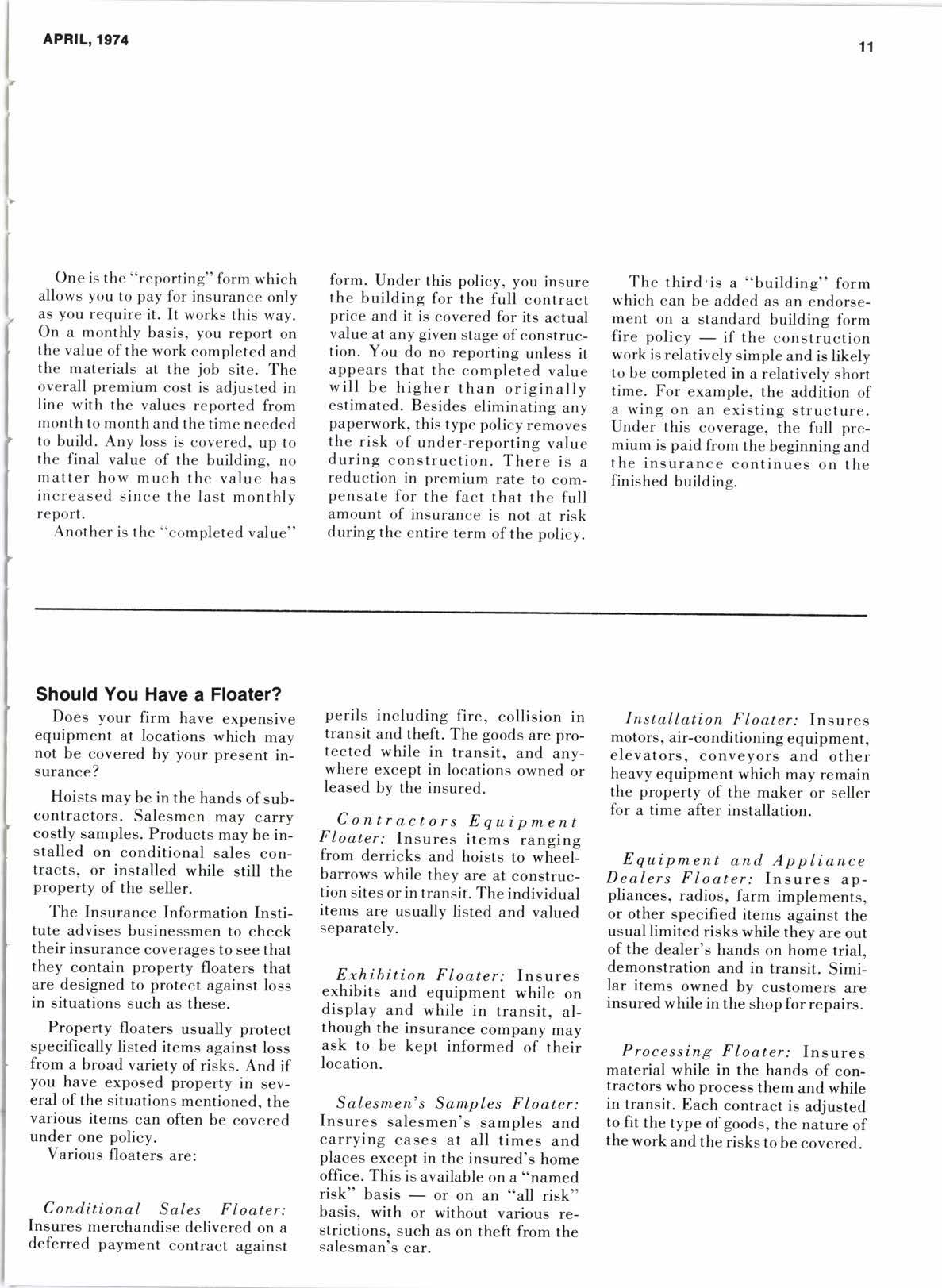
3 minute read
Insu rance Round Up
Adding New Buildings Requires Stepped-up Insurance Coverage
Is your firm in the process ofadding a new building to your business complex?
If so, keep in mind that new construction can be especially susceptible to firesfrom an assortment of flammable materials or dangerous equipment such as acetylene torches used by workmen.
Like other structures, unfinished buildings also can be damaged by windstorms, lightning, vandalisrn and malicious mischief, among other perils.
The Insurance Information Institute warns businessmen against making the mistake of assuming that any damage to the unfinished building will be borne by the builder. It advises the businessman to check his insurance coverage carefully to be sure that he is properly protected in the event of a loss involving new construction.
There are three standard forms of builder's coverage to insure against such losses available to businessmen.
cluding such outlays as special telephone expenses.
For businessmen who want protection against loss of income, however, the lnstitute advises the additional coverage of business interruption insurance.
Simply stated, this coverage is designed to do for the insured business' man--during a period of either total or partial shutdown-what his business would have done if the closing had not occurred.
That is: to guarantee him his 'ooperating income"-out of which must come expenses such as payroll, light, heat, advertising and telephone, to name a few, not to mention his profit, too. if anv.
One is the o'reportingo'form which allows you to pay for insurance only as you require it. It works this way. On a monthly basis, you report on the value of the work completed and the materials at the job site. The overall premium cost is adjusted in line with the values reported from month to month and the time needed to build. Any loss is covered, up to the final value of the building, no matter how much the value has increased since the last monthly report.
Another is the "completed value" form. Under this policy, you insure the building for the full contract price and it is covered for its actual value at any given stage ofconstruction. You do no reporting unless it appears that the completed value will be higher than originally estimated. Besides eliminating any paperworko this type policy removes the risk of under-reporting value during constructio.t. Th"." i. u reduction in premium rate to compensate for the fact that the full amount of insurance is not at risk during the entire term of the policy.
The third'is a "building" form which can be added as an endorsement on a standard building form fire policyif the construction work is relatively simple and is likely to be completed in a relatively short time. For example, the addition of a wing on an existing structure. Under this coverage, the full premium is paid from the beginning and the insurance continues on the finished building.
Should You Have a Floater?
Does your firm have expensive equipment at locations which may not be covered by your present insurance?
Hoists may be in the hands of subcontractors. Salesmen may carry costly samples. Products may be installed on conditional sales contracts, or installed while still the property of the seller.
'fhe Insurance Information Institute advises businessmen to check their insurance coverages to see that they contain property floaters that are designed to protect against loss in situations such as these.
Property floaters usually protect specifically listed items against loss from a broad variety of risks. And if you have exposed property in several of the situations mentioned, the various items can often be covered under one policy.
Various floaters are:
Conditional Sales Floater: Insures merchandise delivered on a deferred payment contract aqainst perils including fire, collision in transit and theft. The goods are protected while in transit. and anvwhere except in locations o*ned or leased by the insured.
Contractors Equipment Floater: lnsures items ranging from derricks and hoists to wlieelbarrows while they are at construction sites or in transit. The individual items are usually listed and valued separately.
Exhi.hition F loater: Insures exhibits and equipment while on display and while in transit, although the insurance company may ask to be kept informed of their location.
Salesmen's Samples Floater: Insures salesmen's samples and carrying cases at all times and places except in the insured's home office. This is available on a 'onamed risk" basisor on an "all risk" basis, with or without various restrictions, such as on theft from the salesman's car.
Installation Floater: Insures motors, air-conditioning equipment, elevators, conveyors and other heavy equipment which may remain the property of the maker or seller for a time after installation.
Equipment and Appliance
Dealers Floater: Insures appliances, radios, farm implements, or other specified items against the usual limited risks while they are out of the dealer's hands on home trial, demonstration and in transit. Similar items owned by customers are insured while in the shop for repairs.
Processing Floater: lnsures material while in the hands of contractors who process them and while in transit. Each contract is adiusted to fit the type of goods. the naiure of the work and the risks to be covered.










